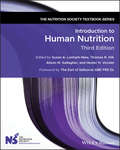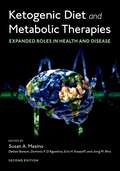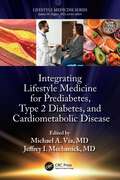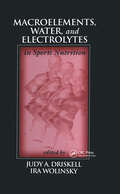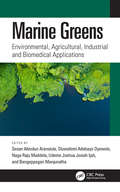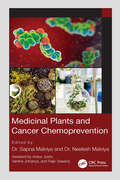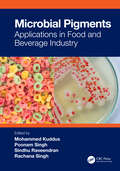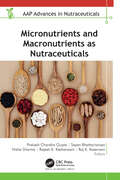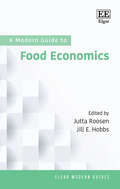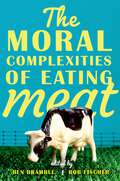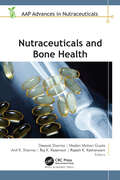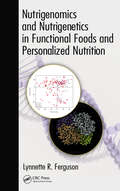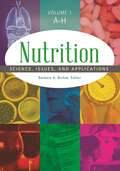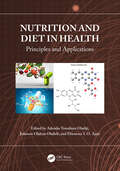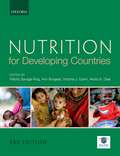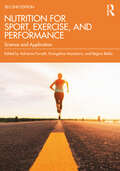- Table View
- List View
Introduction to Human Nutrition (The Nutrition Society Textbook)
Now in its third edition, the best-selling Introduction to Human Nutrition continues to foster an integrated, broad knowledge of the discipline and presents the fundamental principles of nutrition science in an accessible way. With up-to-date coverage of a range of topics from food composition and dietary reference standards to phytochemicals and contemporary challenges of global food safety, this comprehensive text encourages students to think critically about the many factors and influences of human nutrition and health outcomes. Offers a global, multidisciplinary perspective on food and nutrition Covers nutrition and metabolism of proteins, lipids, carbohydrates and vitamins and minerals Explores new developments in functional foods, supplements and food fortification, and future challenges for nutrition research and practice Explains the digestion, absorption, circulatory transport, and cellular uptake of nutrients Demonstrates the structure and characteristics of nutrients, and the relationship with disease prevention A primary text in nutritional science classes worldwide, Introduction to Human Nutrition is a vital resource for students in areas of nutrition, dietetics, and related subjects that involve principles of nutrition science.
Jews and Their Foodways (Studies in Contemporary Jewry)
Food is not just a physical necessity but also a composite commodity. It is part of a communication system, a nonverbal medium for expression, and a marker of special events. Bringing together contributions from fourteen historians, anthropologists, sociologists, and literary critics, Volume XXVIII of Studies in Contemporary Jewry presents various viewpoints on the subtle and intricate relations between Jews and their foodways. The ancient Jewish community ritualized and codified the sphere of food; by regulating specific and detailed culinary laws, Judaism extended and accentuated food's cultural meanings. Modern Jewry is no longer defined exclusively in religious terms, yet a decrease in the role of religion, including kashrut observance, does not necessarily entail any diminishment of the role of food. On the contrary, as shown by the essays in this volume, choices of food take on special importance when Jewish individuals and communities face the challenges of modernity. Following an introduction by Sidney Mintz and concluding with an overview by Richard Wilk, the symposium essays lead the reader from the 20th century to the 21st, across Europe, the Middle East, Africa, and North America. Through periods of war and peace, voluntary immigrations and forced deportations, want and abundance, contemporary Jews use food both for demarcating new borders in rapidly changing circumstances and for remembering a diverse heritage. Despite a tendency in traditional Jewish studies to focus on "high" culture and to marginalize "low" culture, Jews and Their Foodways demonstrates how an examination of people's eating habits helps to explain human life and its diversity through no less than the study of great events, the deeds of famous people, and the writings of distinguished rabbis.
Ketogenic Diet and Metabolic Therapies: Expanded Roles in Health and Disease
Ketogenic diets have treated epilepsy for nearly 100 years, yet metabolic therapy has remained obscure and underutilized for most of this time. In recent decades, the clinical efficacy of ketogenic therapy was confirmed definitively for pediatric epilepsy and has now expanded to adult epilepsy. Now, the benefits of metabolic therapy have been extended well beyond epilepsy to additional neurological, metabolic, and genetic disorders, and the importance of metabolic health is recognized as paramount. This new edition of Ketogenic Diet and Metabolic Therapies: Expanded Roles in Health and Disease highlights the growing research and clinical applications of metabolic therapies as effective in disease treatment, reversal and prevention. Emerging mechanisms include the landscape of the microbiome and epigenetics. Consistent with the first observations in 1921, in some cases metabolism-based strategies have proven equal or superior to pharmacological treatments for specific diseases and for treating multiple comorbidities. This second edition commemorates the 100th anniversary of the ketogenic diet, shares new research in this rapidly moving field, and offers a valuable collection of high-resolution color figures. The team of editors for this edition have been working in this area for decades, and in this volume, they have assembled world leaders in this cutting-edge research. As the first academic, interdisciplinary book on ketogenic diet and metabolic therapy, this volume will be crucial during this time of increased appreciation for metabolic health in professionals and the public alike.
Kitchen knives (Large Print)
This is an image of three kitchen knives. The blades are pointing towards the top of the page and the handles are at the bottom. There is a locator dot shown, which will be at the top left of the page when the image is the correct way up. There are two rivets on each knife handle to secure them to the blade. The sharp edges are to the right of each knife.Test your tactile skills: - Can you find the bread knife with the serrated edge blade?- Find the small paring knife.- Which is the longest knife, the bread knife or the chef's knife on the right of the page?
Kitchen knives (UEB Contracted)
This is an image of three kitchen knives. The blades are pointing towards the top of the page and the handles are at the bottom. There is a locator dot shown, which will be at the top left of the page when the image is the correct way up. There are two rivets on each knife handle to secure them to the blade. The sharp edges are to the right of each knife.Test your tactile skills: - Can you find the bread knife with the serrated edge blade?- Find the small paring knife.- Which is the longest knife, the bread knife or the chef's knife on the right of the page?
Kitchen knives (UEB Uncontracted)
This is an image of three kitchen knives. The blades are pointing towards the top of the page and the handles are at the bottom. There is a locator dot shown, which will be at the top left of the page when the image is the correct way up. There are two rivets on each knife handle to secure them to the blade. The sharp edges are to the right of each knife.Test your tactile skills: - Can you find the bread knife with the serrated edge blade?- Find the small paring knife.- Which is the longest knife, the bread knife or the chef's knife on the right of the page?
Leek (Large Print)
This is an image of a leek standing vertically in the middle of the page. There is a locator dot shown, which will be at the top left of the page when the image is the correct way up. The leek is a member of the Allium family, which includes garlic, onions, shallots and scallions. At the top centre of the page are the leaf tips. There are lines on the image that represent the fine channels running the length of the leaves. The leaves overlap each other and at the bottom of the page, they form a solid bulb, from which the plants roots grow. The plants colour changes from dark green at the top to white at the bottom of the page where the leaves are covered with soil during growth.
Leek (UEB Contracted)
This is an image of a leek standing vertically in the middle of the page. There is a locator dot shown, which will be at the top left of the page when the image is the correct way up. The leek is a member of the Allium family, which includes garlic, onions, shallots and scallions. At the top centre of the page are the leaf tips. There are lines on the image that represent the fine channels running the length of the leaves. The leaves overlap each other and at the bottom of the page, they form a solid bulb, from which the plants roots grow. The plants colour changes from dark green at the top to white at the bottom of the page where the leaves are covered with soil during growth.
Leek (UEB Uncontracted)
This is an image of a leek standing vertically in the middle of the page. There is a locator dot shown, which will be at the top left of the page when the image is the correct way up. The leek is a member of the Allium family, which includes garlic, onions, shallots and scallions. At the top centre of the page are the leaf tips. There are lines on the image that represent the fine channels running the length of the leaves. The leaves overlap each other and at the bottom of the page, they form a solid bulb, from which the plants roots grow. The plants colour changes from dark green at the top to white at the bottom of the page where the leaves are covered with soil during growth.
Lifestyle Medicine for Prediabetes, Type 2 Diabetes, and Cardiometabolic Disease (Lifestyle Medicine)
Lifestyle change is universally recommended for patients with type 2 diabetes and cardiometabolic disease, yet, the majority of clinical practice, educational programs, and clinical trials within these chronic disease spaces focus on medication use and procedures, with insufficient emphasis on lifestyle medicine. The concept of lifestyle medicine can serve as a countermeasure, acting through aspects of personal choice, natural and built environments, cultural traditions, and socioeconomic influences that affect the metabolic health of an individual. Integrating Lifestyle Medicine for Prediabetes, Type 2 Diabetes, and Cardiometabolic Disease provides clinical evidence for and a mechanistic understanding of the six pillars of lifestyle medicine. It guides the reader to identify opportunities for early intervention rather than focus on the diagnosis and treatment of the established disease. Interventions at earlier points have the potential to mitigate progression, prevent complications, reduce costs, and improve a patient’s overall health at all points in their lifetime. Key Features Provides mechanistic, epidemiological, and clinical understanding of all pillars of lifestyle medicine Presents information on mechanisms for lifestyle medicine in cardiometabolic disease Features a unique model that includes recognition of predisease and even pre-predisease with rationale for intervention Promotes evidence-based recommendations for all stages of cardiometabolic disease This volume in the Lifestyle Medicine series is an essential resource for clinicians and students, providing them with information to help them to prevent complications, reduce costs, and improve a patient’s overall health at all points in their lifetime.
Macroelements, Water, and Electrolytes in Sports Nutrition
The media extols the health benefits of good nutrition and physical activity. Since exercise and sport is becoming a bigger concern to the general public and not just elite athletes, the interest in research in this field is growing. Macroelements, Water and Electrolytes in Sport Nutrition addresses the relationship of macroelement needs and interactions to sports and exercise. Research indicates that work capacity and other measures of physical performance are influenced by the intake of water as well as several of the macroelements, including electrolytes. This book examines the convincing, and the not so convincing, evidence about the connection between exercise and sports activities and the nutrient status of individuals.Written by individuals from various academic disciplines, the book is a comprehensive, indispensable resource for scientists and practitioners with an interest in sports nutrition. It provides a review of topics related to water, macroelements, and exercise as well as identifies gaps in our knowledge, encouraging researchers to build upon the existing knowledge and advance our understanding of sport nutrition.
Marine Greens: Environmental, Agricultural, Industrial and Biomedical Applications
This book provides an in-depth overview of marine greens and their environmental and biotechnological applications. It addresses concepts such as the niche adaptation strategies of marine greens in their natural habitats, as well as their global distribution, and factors affecting their distribution and proliferation.Marine greens are posited as an alternative to fossil fuels, mitigating global climate change and thereby fostering future environmental sustainability. In addition, the book explains the remediation of xenobiotics, wastewater, microplastics, marine debris and marine green contamination. Expert authors from around the world explore the industrial and agricultural applications of marine greens in the production of enzymes and marine bioenergy, and what is needed to improve its production potential.This is important reading for government and non-governmental organizations as well as industries and research institutions looking for ways to combat current industrial and environmental challenges.
Medicinal Plants and Cancer Chemoprevention
Cancer is the second leading cause of death globally. Medicinal Plants and Cancer Chemoprevention provides information on the use of various herbal plants used as anticancer agents. It discusses the traditional system of medicine and focuses on plant-derived compounds for cancer therapy with integrated approaches. Chapters present information on various medicinal plants that covers background and history, ethnomedical considerations, morphology, phytochemistry, and pharmacological properties. The book presents a scientific investigation on medicinal plants in managing cancer, reported mechanisms of action as anticancer activity, as well as covering the toxicological aspects of certain plants. KEY FEATURES: · Details information on plant-derived compounds for cancer therapy. · Features information on methods of extraction and isolation of various phytoconstituents responsible for anticancer activity. · Discusses herbal formulations and alternative approaches used for the management and treatment of cancer. · Demonstrates the importance of alternative approaches including yoga, acupuncture, and dietary supplements to be effective in the management of cancer. This book is helpful to botanists, researchers and practitioners in alternative and complementary medicine, and the herbal medicine research community.
Microbial Pigments: Applications in Food and Beverage Industry
Microbial Pigments: Applications in Food and Beverage Industry offers a comprehensive and updated review of the impact of microbial pigments as value-added products in the food and beverage industry. Microbes produce a range of valuable pigments such as carotenoids, flavins, melanins, quinines, and violacein. The book explores the use of microbial pigments as additives, antioxidants, color intensifiers, and functional food ingredients. It discusses pigment isolation and processing technologies. It covers a range of applications across products like jams, spreads, frozen desserts, and beverages. The book also discusses food safety and toxicology aspects. Key features Explores the various microbial pigments and their sources Reviews the pigment isolation, production, and processing techniques Discusses the potential application of pigments across a range of products in the food and beverage industry Includes the latest innovations and patents awarded in use of microbial pigments as value-added food products The book is meant for researchers, academic and industry experts in food biotechnology, food processing, and food microbiology.
Micronutrients and Macronutrients as Nutraceuticals (AAP Advances in Nutraceuticals)
This new volume explains in detail the properties of micronutrients and macronutrients and their diverse uses as nutraceuticals for their beneficial properties, such as their antioxidant activity and immunity-boosting properties and how they can be incorporated into the human diet for optimum health, for growing beneficial bacteria in the gut, and inhibition of pathogens. Interestingly, the authors look at how disease-promoting habits often unfold in childhood, even prenatally, and employing nutrigenomics early on goes a long way toward curbing these chronic diseases later on in life. With the advent of increasing drug costs and escalating antimicrobial resistance, the pharmacological and antibiotic-like effects of naturally derived nutraceuticals are worth exploring. This volume provides important information toward that goal that will be valuable for researchers, faculty, and graduate students in medical microbiology, pharmacy, chemical engineering, and medical informatics.
A Modern Guide to Food Economics (Elgar Modern Guides)
This Modern Guide provides detailed theoretical and empirical insights into key areas of research in food economics. It takes a forward-looking perspective on how different actors in the food system shape the sustainability of food production, distribution, and consumption, as well as on major challenges to efficient and inclusive food systems.Analysing the main characteristics of modern food markets, chapters introduce readers to the economics of food systems, product differentiation, the mediating role of food retailers, and the increasing significance and complexity of international trade in food. Encapsulating new methods in the study of food economics and policy, this Modern Guide explores changes in food value chains and consumption. It further pushes the boundaries of food economics to include economic perspectives on the role of social media and technology such as genomics in shaping food systems.Offering key insights into the state-of-the-art debates in the field, this Modern Guide will be critical reading for graduate students and researchers of food economics. It will also be a timely book for practitioners in the field wishing to take a fresh look at issues shaping food systems.
The Moral Complexities of Eating Meat
A new collection offering provocative and often counterintuitive conclusions on the ethics of meat eating In a world of industralized farming and feed lots, is eating meat ever a morally responsible choice? Is eating organic or free range sufficient to change the moral equation? Is there a moral cost in not eating meat? As billions of animals continue to be raised and killed by human beings for human consumption, affecting the significance and urgency in answering these questions grow. This volume collects twelve new essays by leading moral philosophers who address the difficult questions surrounding meat eating by examining various implications and consequences of our food choices. Some argue for the moral permissibility of eating meat by suggesting views such as farm animals would not exist and flourish otherwise, and the painless death that awaits is no loss to them. Others consider more specific examples like whether buying french fries at McDonalds is just as problematic as ordering a Big Mac due to the action's indirect support of a major purveyor of meat. The Moral Complexities of Eating Meat is a stimulating contribution to the ongoing debate on meat consumption and actively challenges readers to reevlaute their stand on food and animal ethics.
Nutraceuticals and Bone Health (AAP Advances in Nutraceuticals)
Here is an informative volume on the importance of nutraceuticals and herbal remedies for bone health. It explains the probable mechanisms of nutraceuticals for the prevention, treatment, and management of bone-related diseases as well as their curable effects on bone injuries. The volume covers the progression and development of bones, which is a multifaceted process that requires an endless and ample supply of nutrients, such as calcium, phosphorus, potassium, protein, vitamin D, magnesium, and fluoride. The book delves into the beneficial effects of nutraceuticals on overall bone health and for the treatment of bone disorders such as osteoporosis, bone fractures, scoliosis and related complications, rheumatoid arthritis, Paget’s disease, bursitis, gout, and carpal tunnel syndrome. It also addresses the use of nutraceuticals for inflammatory deformities and rickets.
Nutrigenomics and Nutrigenetics in Functional Foods and Personalized Nutrition
While functional foods have become a reasonably well-established concept, personalized nutrition is still treated with skepticism by many. The recognition that people would have different nutrient requirements, or perceive foods in different ways, raises several concerns-some real, some not so real. Nutrigenomics and Nutrigenetics in Functional Foo
Nutrition [2 volumes]: Science, Issues, and Applications [2 volumes]
This thorough one-stop resource draws on solid science and the latest research to play a dual educational role—providing background for students while answering general readers' questions about a wide range of nutrition-related topics.Nutrition is a popular but often misunderstood topic, one about which there is a great deal of interest as evidenced by the plethora of available advice. Because nutrition is a key factor in health, it is important that the public have a source of information they can trust. This is that source: a comprehensive overview that will help readers make sense of conflicting information they find in the media regarding what is healthy and what is not. Organized alphabetically, the two-volume work covers the most important topics in human nutrition including nutrients, nutrition-related health concerns, aging and nutrition, eating disorders, and the value of dietary supplements. The digestive system and its organs are discussed, with particular attention to health issues such as irritable bowel syndrome and the role of helpful bacteria. The physiology of hunger and the psychology of appetite and eating behaviors are explained. The work also delves into data on foods that have been featured in recent research, such as garlic, ginger, and turmeric, and it offers consumers a clearer understanding of nutrition-related practices such as organic farming, genetically modified foods, and the use of food additives.
Nutrition and Diet in Health: Principles and Applications
Nutrition and diet play a crucial role in sustaining good health throughout human lives. Food provides us with essential nutrients involved in many physiological activities and biological processes in the body including growth and development, metabolism, immune function, and overall well-being. Nutrition and Diet in Health: Principles and Applications reviews and discusses the issues related to the roles of nutrition and diet in human health and diseases.The book contains two sections – one section features principles, the other, covers applications. Part I provides information on sustainable use of nutrition and diets in health and diseases; advanced biotechnological approaches to improve nutritional content of food; trace elements in nutrition; drug and nutrient interactions; functional foods and nutraceuticals in health maintenance; and biomarkers of functional foods and nutraceuticals in health maintenance. Part II discusses the significance of nutrition in selected human diseases, including cardiovascular diseases, cancer, infection, neurodegenerative diseases, and metabolic co-morbidities. It also discusses optimal nutrition for wellness, fitness, pregnancy, mental health, aging, and longevity.Features Molecular and cellular-based research findings on the principles and applications of nutrition and diet in health Roles of nutritional agents in the pathogenesis of human diseases Underlying mechanisms that govern activities and strategies to prevent pathological conditions using nutritional agents Nutrition and Diet in Health: Principles and Applications is suitable for academia and scientists, enhances knowledge of students in healthcare and areas of biological sciences.
Nutrition for Developing Countries
Nutrition is an essential component of the work of all health and community workers, including those involved in humanitarian assistance, and yet it is often neglected in their basic training. Drawn from the experiences of an international editor team with extensive field experience, Nutrition for Developing Countries brings together the essential basics of nutrition in an easily accessible form which is accurate, up-to-date and practical, and suitable for a wide range of readers at different levels. The book covers the whole life cycle, including pregnancy, breastfeeding, complementary feeding, older children, adolescents, adults and the elderly, with an emphasis on the most vulnerable women and children. The fully revised and updated edition addresses both the long standing problems of undernutrition and malnutrition, and the growing epidemic of overnutrition and obesity, which are responsible for the rapid increase in non-communicable diseases of later life. Generously illustrated, Nutrition for Developing Countries explains in clear simple language, and practical detail, how nutrition workers can help families with nutrition problems, including many ideas for exercises for training nutrition workers.
Nutrition for Sport, Exercise, and Performance: Science and Application
Nutrition for Sport, Exercise, and Performance offers a clear, practical, and accessible guide to building a comprehensive understanding of sport and exercise nutrition from leading experts in nutrition and exercise science. Nutrition before, during, and after training or a sporting event can improve the comfort, energy, and performance of athletes of all levels, from elite to recreational, as well as providing long-term health benefits. As such, nutrition is a key element of an athlete’s health and performance strategy, whether competing recreationally or at an elite level.Split into three parts, this new and revised edition of Nutrition for Sport, Exercise, and Performance provides an evidence-based introduction to nutrition for sport, exercise, and performance. Part I focusses on nutrition and sport science by explaining key principles underpinning sports nutrition science, including energy systems, exercise physiology and metabolism, and the digestion and absorption of macronutrients and micronutrients essential for performance and discusses factors influencing dietary intake, energy availability, and the process of dietary assessment. Part II is focussed on nutrition for exercise, pre- and post-training, hydration, supplements, and body composition measurement and modification. The final part (Part III) focusses on applied sports nutrition for a range of sports and athletes. This second edition delivers new insights into working with female athletes, occupational athletes, and athletes in contemporary sports including sport climbing, surfing, skateboarding, and breaking.Featuring contributions from a range of sport and exercise nutrition professionals with practical sports nutrition strategies and the latest evidence and practice guidelines, this is a core reference for undergraduate students, sports professionals, and aspiring athletes alike.
Orange (Cross Section) (Large Print)
This is a labelled image of an orange shown in horizontal cross section (cut through from side to side). There is a locator dot shown, which will be at the top left of the page when the image is the correct way up. The orange is shown in centre of the page. The roughly triangular shapes of the segments in cross section are arranged around the centre of the fruit. In each segment, near the centre of the image, there is a pip (seed) shown. This will not always be the case as many varieties have been bred to be seedless. The skin or peel of the orange comprises soft pith covered by a thin layer, commonly known as zest; it contains fruity, aromatic oils and is often used by chefs to add citrus notes to dishes. The orange can vary from six to twelve centimetres in diameter.
Orange (Cross Section) (UEB Contracted)
This is a labelled image of an orange shown in horizontal cross section (cut through from side to side). There is a locator dot shown, which will be at the top left of the page when the image is the correct way up. The orange is shown in centre of the page. The roughly triangular shapes of the segments in cross section are arranged around the centre of the fruit. In each segment, near the centre of the image, there is a pip (seed) shown. This will not always be the case as many varieties have been bred to be seedless. The skin or peel of the orange comprises soft pith covered by a thin layer, commonly known as zest; it contains fruity, aromatic oils and is often used by chefs to add citrus notes to dishes. The orange can vary from six to twelve centimetres in diameter.
